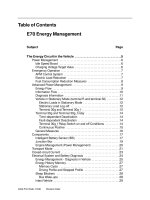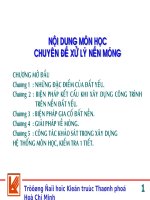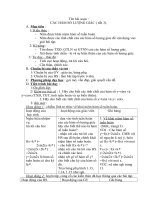C1281 03
Bạn đang xem bản rút gọn của tài liệu. Xem và tải ngay bản đầy đủ của tài liệu tại đây (22.13 KB, 2 trang )
Designation: C 1281 – 03
Standard Specification for
Preformed Tape Sealants for Glazing Applications1
This standard is issued under the fixed designation C 1281; the number immediately following the designation indicates the year of
original adoption or, in the case of revision, the year of last revision. A number in parentheses indicates the year of last reapproval. A
superscript epsilon (e) indicates an editorial change since the last revision or reapproval.
1. Scope
1.1 This specification describes preformed tape sealants for
use in glazing applications. These materials are generally used
to serve as components of glazing systems. They are intended
to serve as a water and air barrier.
1.2 This specification is not intended for preformed foam
tape sealants.
1.3 The values stated in SI units are to be regarded as the
standard. The values in parentheses are provided for information purposes only.
1.4 The subcommittee with jurisdiction is not aware of any
similar ISO standard.
1.5 The following precautionary statement pertains only to
the test method section of this specification. This standard does
not purport to address all of the safety concerns, if any,
associated with its use. It is the responsibility of the user of this
standard to establish appropriate safety and health practices
and determine the applicability of regulatory limitations prior
to use.
C 1016 Test Method for Determination of Water Absorption
of Sealant Backing (Joint Filler) Material2
C 1266 Test Method for Flow Characteristics of Preformed
Tape Sealants2
3. Terminology
3.1 Definitions—The definitions of the following terms used
in this specification are found in Terminology C 717: compression seal, glazing, tape sealant.
4. Materials and Manufacturers
4.1 The preformed tape sealant shall be composed of
appropriate raw materials to result in conformance to this
specification.
4.2 The preformed tape sealant shall be of uniform dimensions and consistency.
4.3 When properly applied, this material shall form a seal to
prevent air and water from entering the system.
5. Requirements
5.1 The tape sealant in the original unopened container shall
meet the requirements of this specification and remain suitable
for use for a minimum of 12 months from the date of
manufacture when stored at a temperature of 26.6°C (80°F)
maximum.
5.2 Physical Properties—The physical properties of the
material shall conform to the requirements specified in Table 1.
2. Referenced Documents
2.1 ASTM Standards:
C 717 Terminology of Building Seals and Sealants2
C 765 Test Method for Low-Temperature Flexibility of
Preformed Tape Sealants2
C 771 Test Method for Weight Loss After Heat Aging of
Preformed Sealing Tapes2
C 772 Test Method for Oil Migration or Plasticizer BleedOut of Preformed Tape Sealants2
C 879 Test Method for Release Papers Used with Preformed
Tape Sealants2
C 908 Test Method for Yield Strength of Preformed Tape
Sealants2
C 972 Test Method for Compression-Recovery of Preformed Tape Sealants2
6. Significance and Use
6.1 This specification describes only preformed tape sealants for glazing applications. Their use is specific under
glazing systems to serve as a water and air barrier. The test
methods chosen are to determine their efficiency in this use.
This specification does not describe all required properties of
the preformed tape sealants. It should be recognized by the
purchaser and design professional that not all preformed tape
sealants meeting this specification are suitable for all applications. In some instances, additional requirements will be agreed
to by the supplier and user.
1
This specification is under the jurisdiction of ASTM Committee C24 on
Building Seals and Sealants and is the direct responsibility of Subcommittee C24.10
on Specifications, Guides and Practices.
Current edition approved May 10, 2003. Published June 2003. Originally
approved in 1994. Last previous edition approved in 1999 as C 1281 – 99.
2
Annual Book of ASTM Standards, Vol 04.07.
Copyright © ASTM International, 100 Barr Harbor Drive, PO Box C700, West Conshohocken, PA 19428-2959, United States.
1
C 1281 – 03
TABLE 1 Material Requirements
Properties
ASTM Test Method
Low Temp Flex
C 765
Weight Loss
Vehicle Migration
C 771
C 772
Backing Removal
C 879,
Alternative A
C 879,
Alternative B
C 908
C 972
Yield Strength
Compression/
Recovery
Water Absorption
C 1016
Flow Test
C 1266
8.3 Weight Loss—Test Method C 771.
8.4 Vehicle Migration—Test Method C 772.
8.5 Backing Removal—Test Method C 879.
8.6 Yield Strength—Test Method C 908.
8.7 Compression/Recovery—Test Method C 972.
8.8 Water Absorption—Test Method C 1016, Procedure A,
with Section 10.1.5 modified as follows: after immersion for 24
h, remove the specimen by picking it up 75 mm (3 in.) from the
ends and blotting gently with an absorbent paper towel, taking
care not to squeeze or press the specimen while blotting.
Within 1 min., place the specimen on the weighing platform
and record the mass of the specimen to the nearest 0.1 g (0.004
oz.).
8.9 Flow Test—Test Method C 1266.
Requirements
No Cracks at − 23°C (−10°F)
No Adhesion Loss
2 % Maximum
1 paper stained maximum and this
stain can be no more than 3.2 mm
(0.125 in.) from edge of sample
maximum
No transfer of tape compound to the
paper.
No transfer of tape compound to the
paper
41.4 kPa (6 psi) minimum
122 N/cm3(450 lbf/in.3) max.
Compression Index
0.04 g/cm3 Weight Gain maximum
after blotting
60 % max Loss of Height
9. Packaging and Package Marking
9.1 Unless otherwise specified in the contract or order, the
material shall be packaged in standard commercial containers
constructed to ensure acceptance by common or other carrier
for safe transportation to the point of delivery.
9.2 Shipping containers shall be marked with the name,
grade, and quantity of the material contained therein, as defined
by the contract or order under which the shipments are made.
The name of the manufacturer, the lot and batch number of the
contract or order, and the date of manufacture shall also be
shown.
7. Sampling
7.1 The preformed tape sealant to be tested for conformance
with the requirements of this specification shall be taken
directly from a randomly selected commercial container as
supplied by the manufacturer.
8. Test Methods
8.1 All test methods described in the following paragraphs,
unless otherwise indicated, shall be performed in a laboratory
controlled at 23 6 2°C (73.4 6 3.6°F). This preformed tape
sealant sample shall be conditioned at this temperature for at
least 24 h before laboratory tests are preformed.
8.2 Low Temperature Flexibility—Test Method C 765.
10. Keywords
10.1 glazing; glazing tapes; preformed tape sealant; tape
specification
ASTM International takes no position respecting the validity of any patent rights asserted in connection with any item mentioned
in this standard. Users of this standard are expressly advised that determination of the validity of any such patent rights, and the risk
of infringement of such rights, are entirely their own responsibility.
This standard is subject to revision at any time by the responsible technical committee and must be reviewed every five years and
if not revised, either reapproved or withdrawn. Your comments are invited either for revision of this standard or for additional standards
and should be addressed to ASTM International Headquarters. Your comments will receive careful consideration at a meeting of the
responsible technical committee, which you may attend. If you feel that your comments have not received a fair hearing you should
make your views known to the ASTM Committee on Standards, at the address shown below.
This standard is copyrighted by ASTM International, 100 Barr Harbor Drive, PO Box C700, West Conshohocken, PA 19428-2959,
United States. Individual reprints (single or multiple copies) of this standard may be obtained by contacting ASTM at the above
address or at 610-832-9585 (phone), 610-832-9555 (fax), or (e-mail); or through the ASTM website
(www.astm.org).
2





![MAKE magazine [OH] 03](https://media.store123doc.com/images/document/13/ce/fj/medium_fjg1388298702.jpg)



